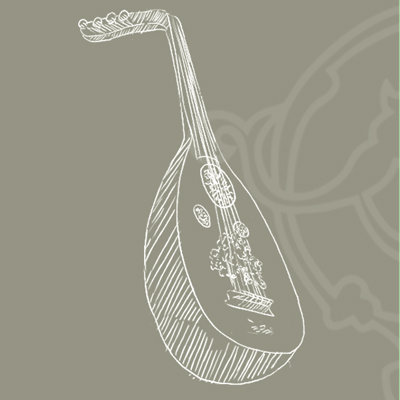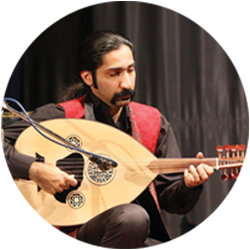Lute is a stringed instrument which is common in the Middle East and Arabic countries. Lute is one of the old eastern and Iranian music instrument. Since the body of Lute is wooden, it is called Ud (Ud in Arabic means wood). It is in different sizes and the most common size is the Iranian Lute. Arabic Lutes have big sound boxes but Turkish ones have small sound boxes and the Iranian ones are medium.
In the past, there were two types of Lutes: one was with big sound box and short neck, another one was with a small sound box and a long neck. Today, long neck Lute is called “Barbat” but it is an obvious mistake. Base on the studies, both of these instruments are Lute and they have a same sound building.
Lute has a big and pear-liked body and it is made up of a number of separate ribs. Its neck is too short, and then the most part of the strings are along the body. Its body is wooden and the sound hole is reticulated. The bridge of lute is short and somehow linear. Lute has 10 strings or 5 pair strings but some masters break the traditional form of it and add one or two strings before the second string. The pair strings have the same sound or tune in but every string has its own ear. The ears are on two sides of Lute’s head.
Lute has the most bass sound in the stringed instruments. The note of Lute is written with treble clef that is totally two octaves and it is heard one octave higher than the note. The sound of Lute is equal to the fourth octave of piano from right to left. In principle, Lute has to be played with Fa clef. Thus, its real sound is one octave lower than that is common nowadays.
The plectrum of Lute is from hen, peacock, or eagle feature and sometimes other fabrics are used as the plectrum. Now, players use plastic plectrums.
The sound of Lute is not only bass and soft, but also charming and warm. Lute is played either solo or more often as part of an ensemble.

Instructor:
- B.A. in Playing of Persian Instruments from Tehran University of Art
- Instructor at Guilan University
- Arash Saeediyan began studying music with Tombak and percussion instruments in 1998. He also learned to play Oud, Setar, Tanbour, Dotar and etc.
- He learned under the supervision of the maestros, Mohammad Reza Lotfi, Hossein Mehrani, and Mohammad Reza Ebrahimi.
- Arash Saeediyan cooperated with many different music bands such as Hamnavazan, Khamoush, Mahtabroo, and Kohan. He also performed in many Iranian and international festivals and concerts such as the joint performance of Ud with the great maestro of the contemporary world in Oud, Naseer Shamma under the supervision of Saye-e Roshan music band at the Al-anshade Music Festival in Algeria in 2015, Participation in different Fajr International Music Festival editions, and participation in Persian Classical Music Festival. He performed in various concerts and festivals.
- He collaborated with Maestro Majid Derakhshani in Khorshid music band and he also participated in the record of his albums. He also collaborated on the record of many albums as a musician or a composer such as Sahhar Khani, Norouz Saba, Badban Shekasteh, Sarkhosh, Narang and etc.
- “Sahar Khani” album won the award for the best traditional album at Iraj Bastami’s Festival in 2014.
 WhatsApp us
WhatsApp us
